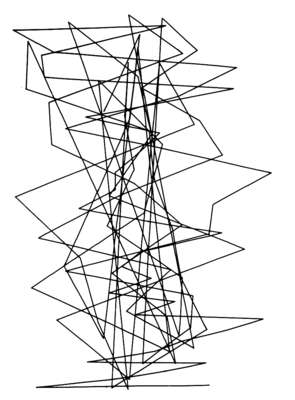A. MICHAEL NOLL is a Professor Emeritus of Communication at the Annenberg School for Communication of the University of Southern California in Los Angeles. He taught courses in communication systems technology, and he continues to study the policy and social implications of communication technologies. Before joining the Annenberg School in 1984, Dr. Noll had a varied career in basic research (at the Bell Telephone Laboratories Inc. in Murray Hill, New Jersey, since 1961), telecommunication marketing and science policy.
His research has included work in the areas of the effects of media on interpersonal communication, three-dimensional computer graphics, human-machine tactile communication, speech signal processing, and aesthetics.
He is one of the first pioneers in the use of digital computers in the visual arts, and his computer art has been widely exhibited throughout the world. He created his earliest digital computer art in the summer of 1962, and the first public exhibition of his computer art (along with random patterns for studies of recognition, by Dr. Bela Julesz) was put up at the Howard Wise Gallery in New York City from 6 to 24 April, 1965. This was the earliest such exhibition in the United States, and the second world-wide.
(Noll’s pioneering work is documented by a Bell Telephone Laboratories Technical Memorandum of the title “Patterns by 7090” (memo no. MM-62-1234-14, August 28, 1962. The term “7090” here indicates the then popular IBM 7090 mainframe computer in use at Bell, and available to Dr. Noll.)
Noll’s prototypical study of computer-generated ballet was created in the early 1960’s and was the first such use of computers. His experimental study of aesthetic preferences for a computer-generated simulation of a painting by Piet Mondrian has become a classic. In the late 1960 and early 1970’s, he constructed interactive three-dimensional input devices and displays and a three-dimensional, tactile, force-feedback (“feelie”) device. They were the forerunners of devices in use with today’s virtual-reality systems.
His “Computer-Generated Ballet” was the first use of a digital computer to create an animation of stick figures on a virtual stage. In 1968 and 1970, he utilized his four-dimensional computer-animation method to create the title sequences for a movie (“Incredible Machine”) and for a television special (“The Unexplained”) – a very early use of computer animation for generating title sequences.
He has served as the Technical Assistant to the President’s Science Advisor at the White House in the early 1970’s and was involved with computer security and privacy, computer exports, scientific and technical information, educational technology and federal research programs in the USA. He served as the first Co-Chair of a joint USA/USSR program in the application of computers to management.
Dr. Noll has published over ninety-five professional papers covering a wide variety of topics. While at Bell Telephone Laboratoriess, he was granted six patents for his inventions in speech processing and human-machine tactile communication.
He currently writes a column in Telecommunications Online. In addition, Dr. Noll wrote reviews of classical music performances for the Classical New Jersey Society.
Dr. Noll’s works are represented in the permanent collections of the New York Museum of Modern Art, the Los Angeles County Museum of Art, the USC Fisher Gallery, the Performing Arts Library at Lincoln Center for the Performing Arts in New York City, and the Academy of Motion Picture Arts and Sciences.









